overheating VOLVO XC90 TWIN ENGINE HYBRID 2017 Owners Manual
[x] Cancel search | Manufacturer: VOLVO, Model Year: 2017, Model line: XC90 TWIN ENGINE HYBRID, Model: VOLVO XC90 TWIN ENGINE HYBRID 2017Pages: 584, PDF Size: 14.2 MB
Page 10 of 584
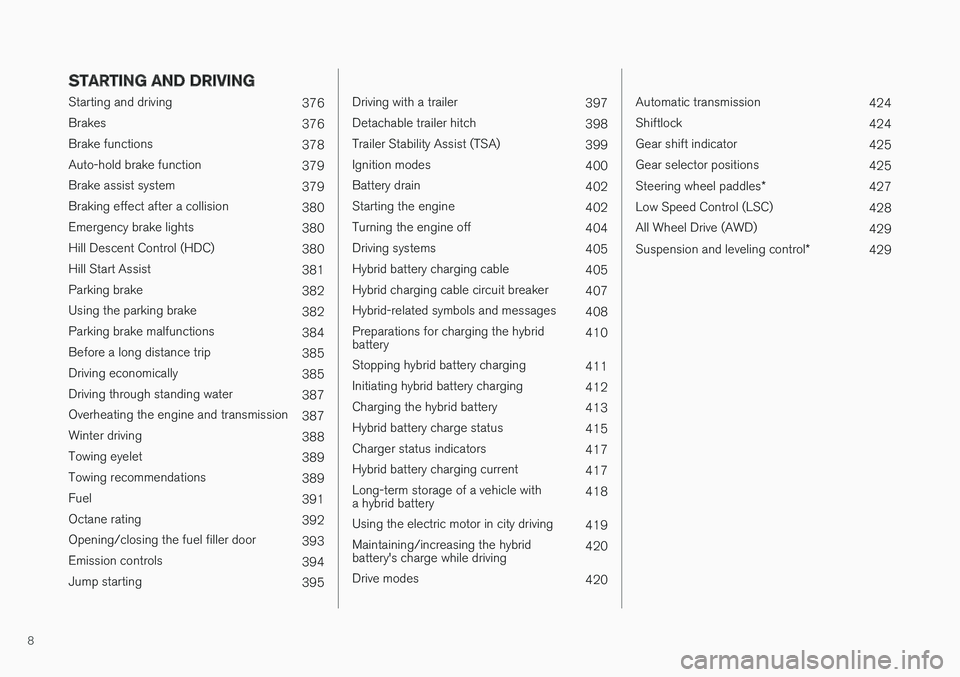
8
STARTING AND DRIVING
Starting and driving376
Brakes376
Brake functions378
Auto-hold brake function379
Brake assist system379
Braking effect after a collision380
Emergency brake lights380
Hill Descent Control (HDC)380
Hill Start Assist381
Parking brake382
Using the parking brake382
Parking brake malfunctions384
Before a long distance trip385
Driving economically385
Driving through standing water387
Overheating the engine and transmission387
Winter driving388
Towing eyelet389
Towing recommendations389
Fuel391
Octane rating392
Opening/closing the fuel filler door393
Emission controls394
Jump starting395
Driving with a trailer397
Detachable trailer hitch398
Trailer Stability Assist (TSA)399
Ignition modes400
Battery drain402
Starting the engine402
Turning the engine off404
Driving systems405
Hybrid battery charging cable405
Hybrid charging cable circuit breaker407
Hybrid-related symbols and messages408
Preparations for charging the hybridbattery410
Stopping hybrid battery charging411
Initiating hybrid battery charging412
Charging the hybrid battery413
Hybrid battery charge status415
Charger status indicators417
Hybrid battery charging current417
Long-term storage of a vehicle witha hybrid battery418
Using the electric motor in city driving419
Maintaining/increasing the hybridbattery's charge while driving420
Drive modes420
Automatic transmission424
Shiftlock424
Gear shift indicator425
Gear selector positions425
Steering wheel paddles*427
Low Speed Control (LSC)428
All Wheel Drive (AWD)429
Suspension and leveling control*429
Page 389 of 584
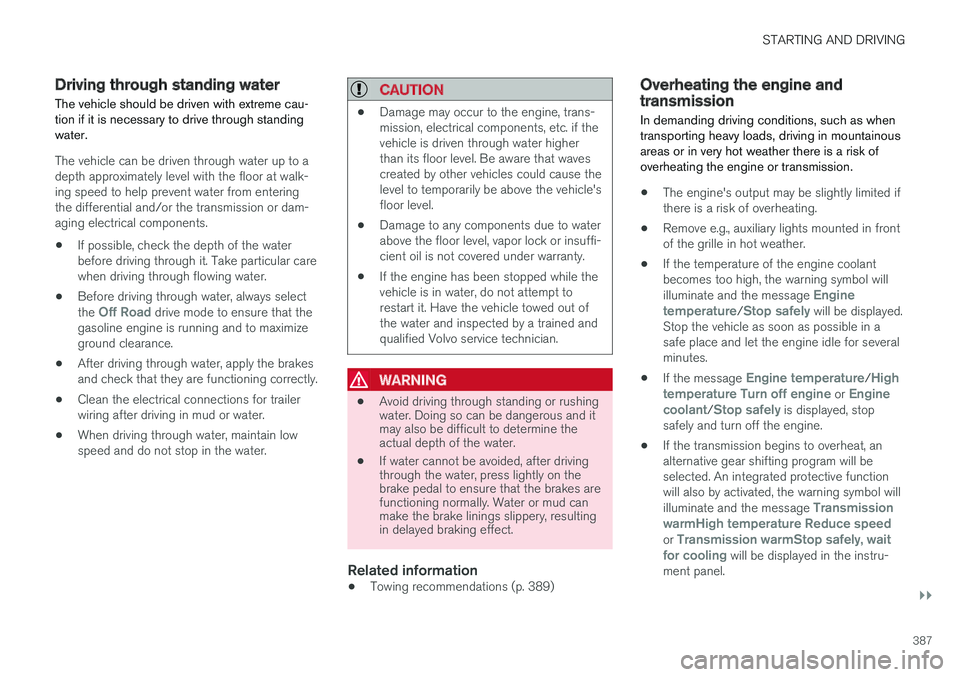
STARTING AND DRIVING
}}
387
Driving through standing water
The vehicle should be driven with extreme cau-tion if it is necessary to drive through standingwater.
The vehicle can be driven through water up to adepth approximately level with the floor at walk-ing speed to help prevent water from enteringthe differential and/or the transmission or dam-aging electrical components.
•If possible, check the depth of the waterbefore driving through it. Take particular carewhen driving through flowing water.
•Before driving through water, always selectthe Off Road drive mode to ensure that thegasoline engine is running and to maximizeground clearance.
•After driving through water, apply the brakesand check that they are functioning correctly.
•Clean the electrical connections for trailerwiring after driving in mud or water.
•When driving through water, maintain lowspeed and do not stop in the water.
CAUTION
•Damage may occur to the engine, trans-mission, electrical components, etc. if thevehicle is driven through water higherthan its floor level. Be aware that wavescreated by other vehicles could cause thelevel to temporarily be above the vehicle'sfloor level.
•Damage to any components due to waterabove the floor level, vapor lock or insuffi-cient oil is not covered under warranty.
•If the engine has been stopped while thevehicle is in water, do not attempt torestart it. Have the vehicle towed out ofthe water and inspected by a trained andqualified Volvo service technician.
WARNING
•Avoid driving through standing or rushingwater. Doing so can be dangerous and itmay also be difficult to determine theactual depth of the water.
•If water cannot be avoided, after drivingthrough the water, press lightly on thebrake pedal to ensure that the brakes arefunctioning normally. Water or mud canmake the brake linings slippery, resultingin delayed braking effect.
Related information
•Towing recommendations (p. 389)
Overheating the engine andtransmission
In demanding driving conditions, such as whentransporting heavy loads, driving in mountainousareas or in very hot weather there is a risk ofoverheating the engine or transmission.
•The engine's output may be slightly limited ifthere is a risk of overheating.
•Remove e.g., auxiliary lights mounted in frontof the grille in hot weather.
•If the temperature of the engine coolantbecomes too high, the warning symbol willilluminate and the message Enginetemperature/Stop safely will be displayed.Stop the vehicle as soon as possible in asafe place and let the engine idle for severalminutes.
•If the message Engine temperature/Hightemperature Turn off engine or Enginecoolant/Stop safely is displayed, stopsafely and turn off the engine.
•If the transmission begins to overheat, analternative gear shifting program will beselected. An integrated protective functionwill also by activated, the warning symbol willilluminate and the message TransmissionwarmHigh temperature Reduce speedor Transmission warmStop safely, waitfor cooling will be displayed in the instru-ment panel.
Page 396 of 584
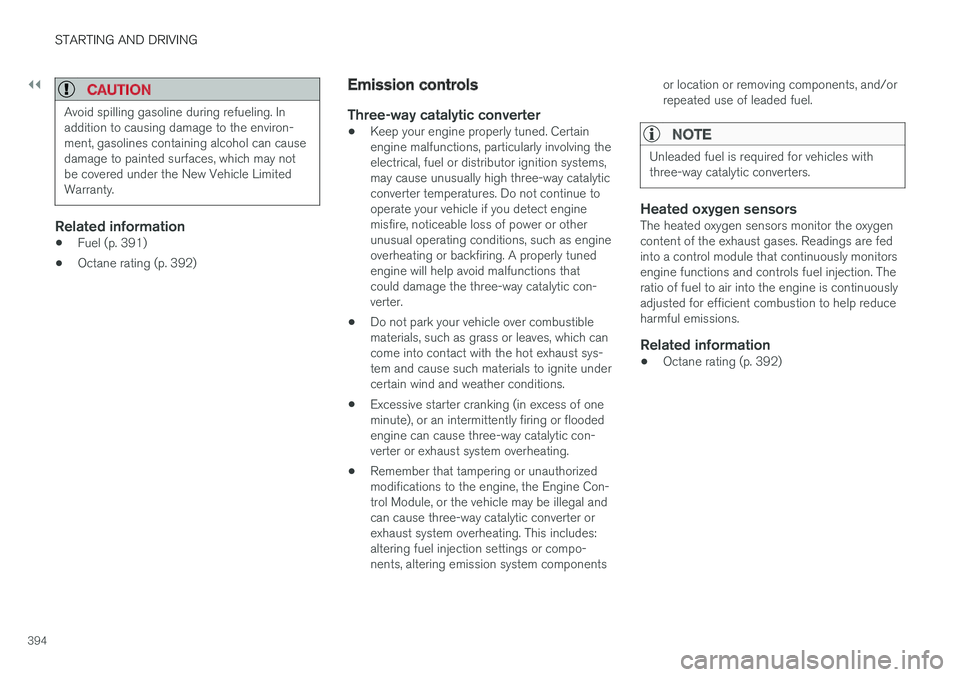
||
STARTING AND DRIVING
394
CAUTION
Avoid spilling gasoline during refueling. Inaddition to causing damage to the environ-ment, gasolines containing alcohol can causedamage to painted surfaces, which may notbe covered under the New Vehicle LimitedWarranty.
Related information
•Fuel (p. 391)
•Octane rating (p. 392)
Emission controls
Three-way catalytic converter
•Keep your engine properly tuned. Certainengine malfunctions, particularly involving theelectrical, fuel or distributor ignition systems,may cause unusually high three-way catalyticconverter temperatures. Do not continue tooperate your vehicle if you detect enginemisfire, noticeable loss of power or otherunusual operating conditions, such as engineoverheating or backfiring. A properly tunedengine will help avoid malfunctions thatcould damage the three-way catalytic con-verter.
•Do not park your vehicle over combustiblematerials, such as grass or leaves, which cancome into contact with the hot exhaust sys-tem and cause such materials to ignite undercertain wind and weather conditions.
•Excessive starter cranking (in excess of oneminute), or an intermittently firing or floodedengine can cause three-way catalytic con-verter or exhaust system overheating.
•Remember that tampering or unauthorizedmodifications to the engine, the Engine Con-trol Module, or the vehicle may be illegal andcan cause three-way catalytic converter orexhaust system overheating. This includes:altering fuel injection settings or compo-nents, altering emission system components
or location or removing components, and/orrepeated use of leaded fuel.
NOTE
Unleaded fuel is required for vehicles withthree-way catalytic converters.
Heated oxygen sensors
The heated oxygen sensors monitor the oxygencontent of the exhaust gases. Readings are fedinto a control module that continuously monitorsengine functions and controls fuel injection. Theratio of fuel to air into the engine is continuouslyadjusted for efficient combustion to help reduceharmful emissions.
Related information
•Octane rating (p. 392)
Page 404 of 584
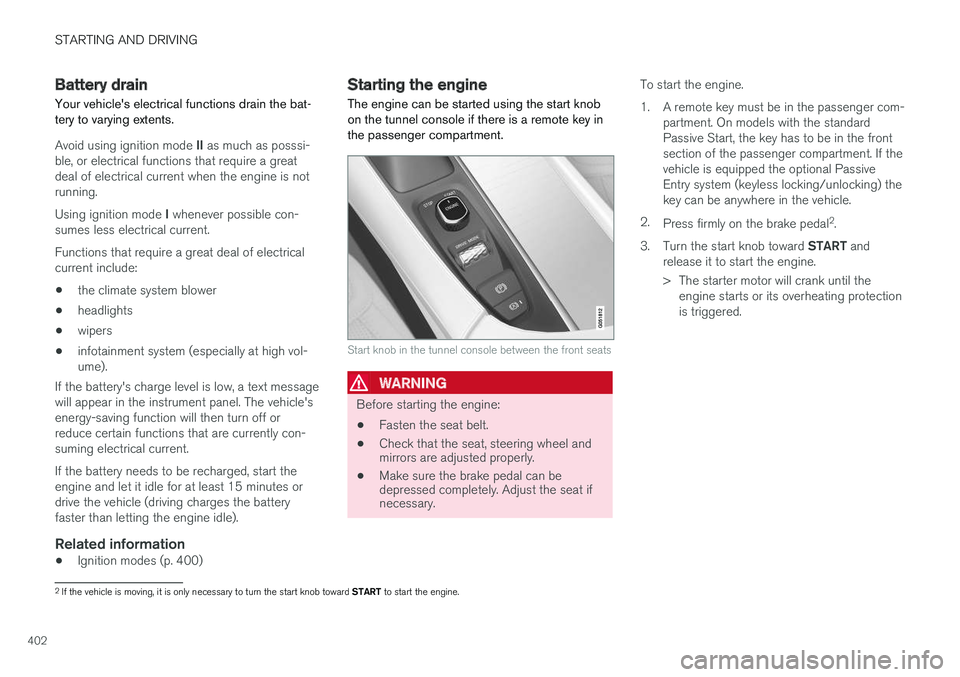
STARTING AND DRIVING
402
Battery drain
Your vehicle's electrical functions drain the bat-tery to varying extents.
Avoid using ignition mode II as much as posssi-ble, or electrical functions that require a greatdeal of electrical current when the engine is notrunning.
Using ignition mode I whenever possible con-sumes less electrical current.
Functions that require a great deal of electricalcurrent include:
•the climate system blower
•headlights
•wipers
•infotainment system (especially at high vol-ume).
If the battery's charge level is low, a text messagewill appear in the instrument panel. The vehicle'senergy-saving function will then turn off orreduce certain functions that are currently con-suming electrical current.
If the battery needs to be recharged, start theengine and let it idle for at least 15 minutes ordrive the vehicle (driving charges the batteryfaster than letting the engine idle).
Related information
•Ignition modes (p. 400)
Starting the engine
The engine can be started using the start knobon the tunnel console if there is a remote key inthe passenger compartment.
Start knob in the tunnel console between the front seats
WARNING
Before starting the engine:
•Fasten the seat belt.
•Check that the seat, steering wheel andmirrors are adjusted properly.
•Make sure the brake pedal can bedepressed completely. Adjust the seat ifnecessary.
To start the engine.
1.A remote key must be in the passenger com-partment. On models with the standardPassive Start, the key has to be in the frontsection of the passenger compartment. If thevehicle is equipped the optional PassiveEntry system (keyless locking/unlocking) thekey can be anywhere in the vehicle.
2.Press firmly on the brake pedal2.
3.Turn the start knob toward START andrelease it to start the engine.
> The starter motor will crank until theengine starts or its overheating protectionis triggered.
2If the vehicle is moving, it is only necessary to turn the start knob toward START to start the engine.
Page 406 of 584
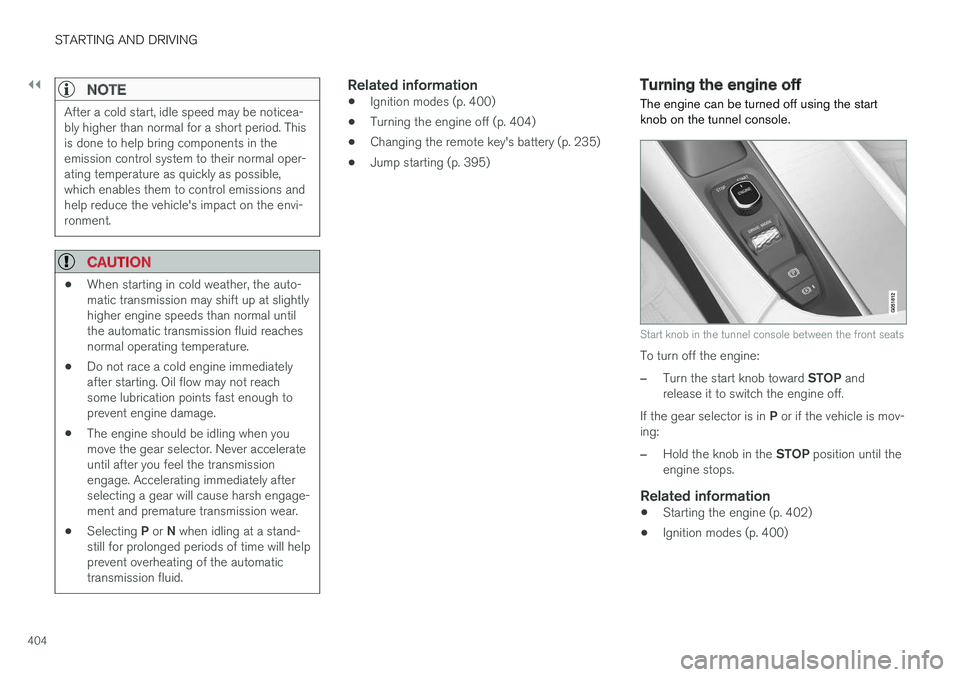
||
STARTING AND DRIVING
404
NOTE
After a cold start, idle speed may be noticea-bly higher than normal for a short period. Thisis done to help bring components in theemission control system to their normal oper-ating temperature as quickly as possible,which enables them to control emissions andhelp reduce the vehicle's impact on the envi-ronment.
CAUTION
•When starting in cold weather, the auto-matic transmission may shift up at slightlyhigher engine speeds than normal untilthe automatic transmission fluid reachesnormal operating temperature.
•Do not race a cold engine immediatelyafter starting. Oil flow may not reachsome lubrication points fast enough toprevent engine damage.
•The engine should be idling when youmove the gear selector. Never accelerateuntil after you feel the transmissionengage. Accelerating immediately afterselecting a gear will cause harsh engage-ment and premature transmission wear.
•Selecting P or N when idling at a stand-still for prolonged periods of time will helpprevent overheating of the automatictransmission fluid.
Related information
•Ignition modes (p. 400)
•Turning the engine off (p. 404)
•Changing the remote key's battery (p. 235)
•Jump starting (p. 395)
Turning the engine off
The engine can be turned off using the startknob on the tunnel console.
Start knob in the tunnel console between the front seats
To turn off the engine:
–Turn the start knob toward STOP andrelease it to switch the engine off.
If the gear selector is in P or if the vehicle is mov-ing:
–Hold the knob in the STOP position until theengine stops.
Related information
•Starting the engine (p. 402)
•Ignition modes (p. 400)
Page 412 of 584
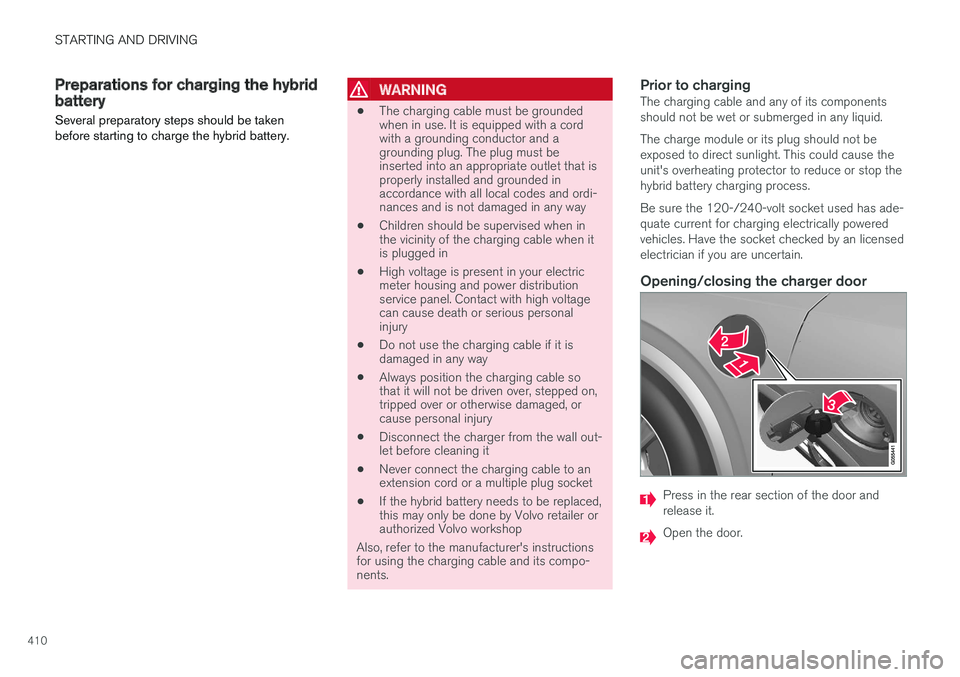
STARTING AND DRIVING
410
Preparations for charging the hybridbattery
Several preparatory steps should be takenbefore starting to charge the hybrid battery.
WARNING
•The charging cable must be groundedwhen in use. It is equipped with a cordwith a grounding conductor and agrounding plug. The plug must beinserted into an appropriate outlet that isproperly installed and grounded inaccordance with all local codes and ordi-nances and is not damaged in any way
•Children should be supervised when inthe vicinity of the charging cable when itis plugged in
•High voltage is present in your electricmeter housing and power distributionservice panel. Contact with high voltagecan cause death or serious personalinjury
•Do not use the charging cable if it isdamaged in any way
•Always position the charging cable sothat it will not be driven over, stepped on,tripped over or otherwise damaged, orcause personal injury
•Disconnect the charger from the wall out-let before cleaning it
•Never connect the charging cable to anextension cord or a multiple plug socket
•If the hybrid battery needs to be replaced,this may only be done by Volvo retailer orauthorized Volvo workshop
Also, refer to the manufacturer's instructionsfor using the charging cable and its compo-nents.
Prior to charging
The charging cable and any of its componentsshould not be wet or submerged in any liquid.
The charge module or its plug should not beexposed to direct sunlight. This could cause theunit's overheating protector to reduce or stop thehybrid battery charging process.
Be sure the 120-/240-volt socket used has ade-quate current for charging electrically poweredvehicles. Have the socket checked by an licensedelectrician if you are uncertain.
Opening/closing the charger door
Press in the rear section of the door andrelease it.
Open the door.
Page 415 of 584
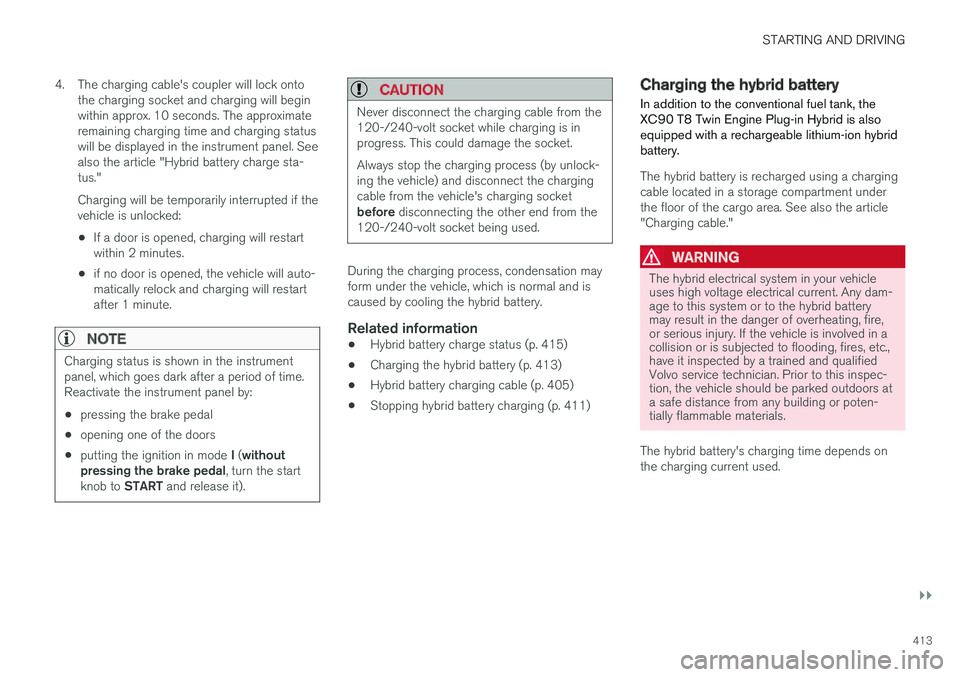
STARTING AND DRIVING
}}
413
4.The charging cable's coupler will lock ontothe charging socket and charging will beginwithin approx. 10 seconds. The approximateremaining charging time and charging statuswill be displayed in the instrument panel. Seealso the article "Hybrid battery charge sta-tus."
Charging will be temporarily interrupted if thevehicle is unlocked:
•If a door is opened, charging will restartwithin 2 minutes.
•if no door is opened, the vehicle will auto-matically relock and charging will restartafter 1 minute.
NOTE
Charging status is shown in the instrumentpanel, which goes dark after a period of time.Reactivate the instrument panel by:
•pressing the brake pedal
•opening one of the doors
•putting the ignition in mode I (withoutpressing the brake pedal, turn the startknob to START and release it).
CAUTION
Never disconnect the charging cable from the120-/240-volt socket while charging is inprogress. This could damage the socket.
Always stop the charging process (by unlock-ing the vehicle) and disconnect the chargingcable from the vehicle's charging socketbefore disconnecting the other end from the120-/240-volt socket being used.
During the charging process, condensation mayform under the vehicle, which is normal and iscaused by cooling the hybrid battery.
Related information
•Hybrid battery charge status (p. 415)
•Charging the hybrid battery (p. 413)
•Hybrid battery charging cable (p. 405)
•Stopping hybrid battery charging (p. 411)
Charging the hybrid battery
In addition to the conventional fuel tank, theXC90 T8 Twin Engine Plug-in Hybrid is alsoequipped with a rechargeable lithium-ion hybridbattery.
The hybrid battery is recharged using a chargingcable located in a storage compartment underthe floor of the cargo area. See also the article"Charging cable."
WARNING
The hybrid electrical system in your vehicleuses high voltage electrical current. Any dam-age to this system or to the hybrid batterymay result in the danger of overheating, fire,or serious injury. If the vehicle is involved in acollision or is subjected to flooding, fires, etc.,have it inspected by a trained and qualifiedVolvo service technician. Prior to this inspec-tion, the vehicle should be parked outdoors ata safe distance from any building or poten-tially flammable materials.
The hybrid battery's charging time depends onthe charging current used.
Page 486 of 584
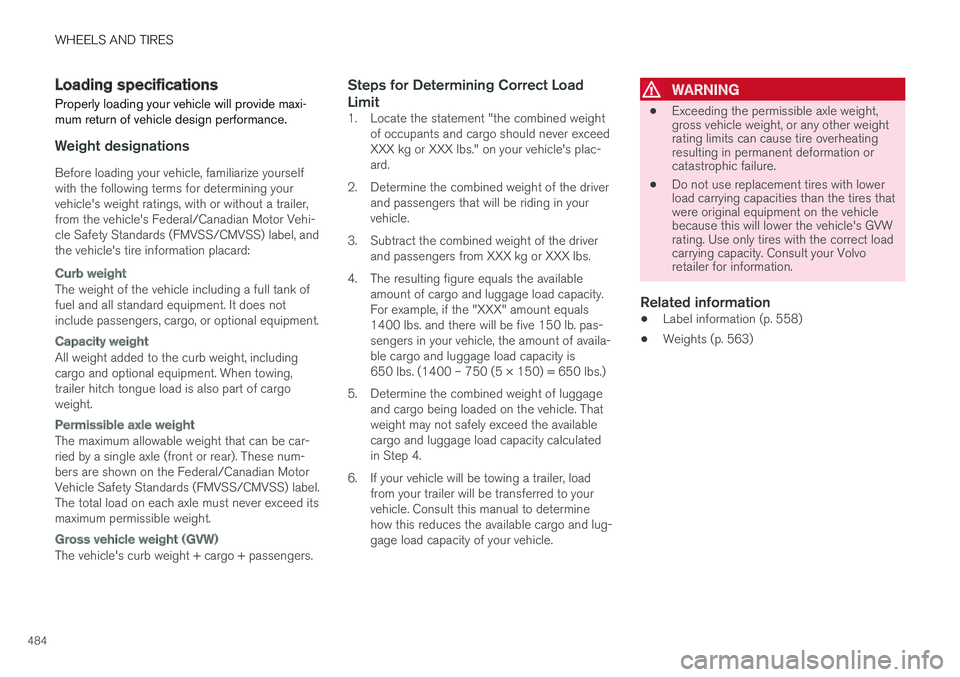
WHEELS AND TIRES
484
Loading specifications
Properly loading your vehicle will provide maxi-mum return of vehicle design performance.
Weight designations
Before loading your vehicle, familiarize yourselfwith the following terms for determining yourvehicle's weight ratings, with or without a trailer,from the vehicle's Federal/Canadian Motor Vehi-cle Safety Standards (FMVSS/CMVSS) label, andthe vehicle's tire information placard:
Curb weight
The weight of the vehicle including a full tank offuel and all standard equipment. It does notinclude passengers, cargo, or optional equipment.
Capacity weight
All weight added to the curb weight, includingcargo and optional equipment. When towing,trailer hitch tongue load is also part of cargoweight.
Permissible axle weight
The maximum allowable weight that can be car-ried by a single axle (front or rear). These num-bers are shown on the Federal/Canadian MotorVehicle Safety Standards (FMVSS/CMVSS) label.The total load on each axle must never exceed itsmaximum permissible weight.
Gross vehicle weight (GVW)
The vehicle's curb weight + cargo + passengers.
Steps for Determining Correct Load
Limit
1. Locate the statement "the combined weightof occupants and cargo should never exceedXXX kg or XXX lbs." on your vehicle's plac-ard.
2. Determine the combined weight of the driverand passengers that will be riding in yourvehicle.
3. Subtract the combined weight of the driverand passengers from XXX kg or XXX lbs.
4. The resulting figure equals the availableamount of cargo and luggage load capacity.For example, if the "XXX" amount equals1400 lbs. and there will be five 150 lb. pas-sengers in your vehicle, the amount of availa-ble cargo and luggage load capacity is650 lbs. (1400 – 750 (5 × 150) = 650 lbs.)
5. Determine the combined weight of luggageand cargo being loaded on the vehicle. Thatweight may not safely exceed the availablecargo and luggage load capacity calculatedin Step 4.
6. If your vehicle will be towing a trailer, loadfrom your trailer will be transferred to yourvehicle. Consult this manual to determinehow this reduces the available cargo and lug-gage load capacity of your vehicle.
WARNING
•Exceeding the permissible axle weight,gross vehicle weight, or any other weightrating limits can cause tire overheatingresulting in permanent deformation orcatastrophic failure.
•Do not use replacement tires with lowerload carrying capacities than the tires thatwere original equipment on the vehiclebecause this will lower the vehicle's GVWrating. Use only tires with the correct loadcarrying capacity. Consult your Volvoretailer for information.
Related information
•Label information (p. 558)
•Weights (p. 563)
Page 576 of 584
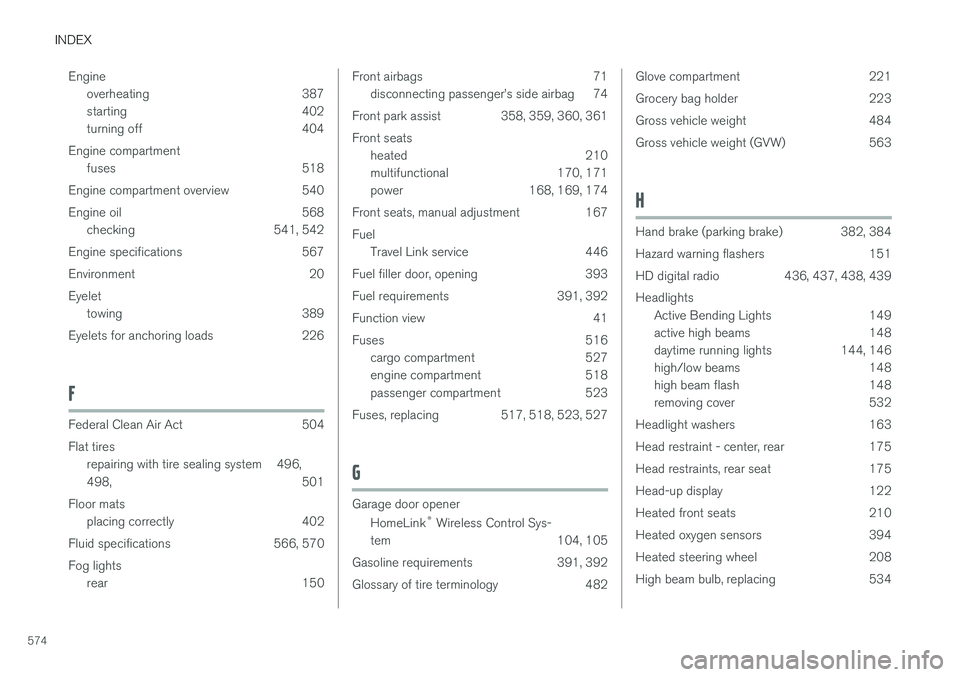
INDEX
574
Engine
overheating 387
starting 402
turning off 404
Engine compartment
fuses 518
Engine compartment overview 540
Engine oil 568
checking 541, 542
Engine specifications 567
Environment 20
Eyelet
towing 389
Eyelets for anchoring loads 226
F
Federal Clean Air Act504
Flat tires
repairing with tire sealing system496,
498, 501
Floor mats
placing correctly402
Fluid specifications566, 570
Fog lights
rear150
Front airbags71
disconnecting passenger
Page 578 of 584
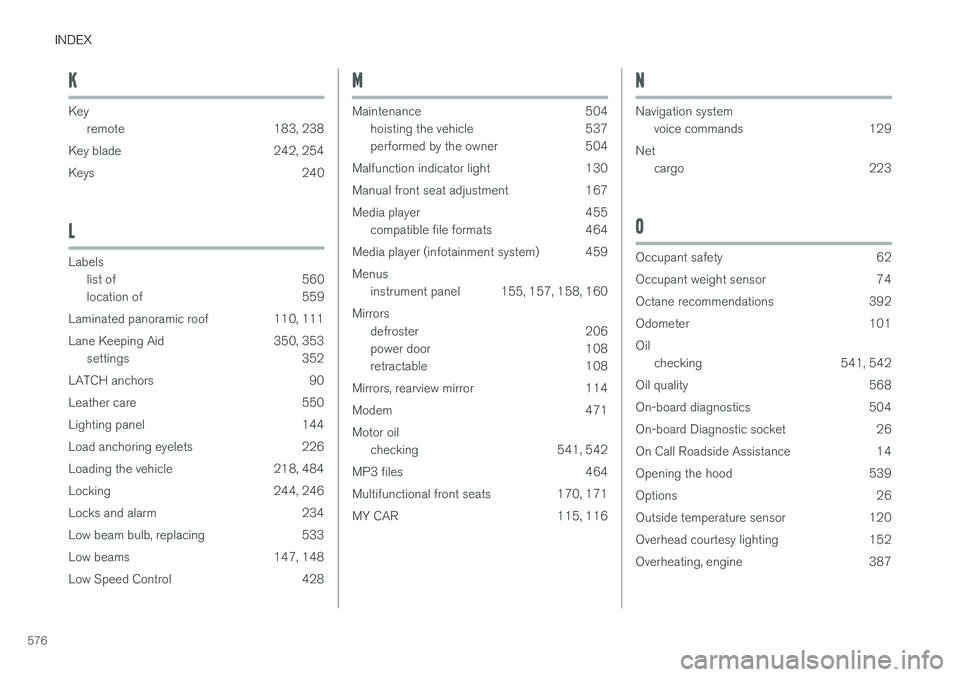
INDEX
576
K
Key
remote183, 238
Key blade242, 254
Keys240
L
Labels
list of560
location of559
Laminated panoramic roof 110, 111
Lane Keeping Aid 350, 353
settings 352
LATCH anchors 90
Leather care 550
Lighting panel 144
Load anchoring eyelets 226
Loading the vehicle 218, 484
Locking 244, 246
Locks and alarm 234
Low beam bulb, replacing 533
Low beams 147, 148
Low Speed Control 428
M
Maintenance504
hoisting the vehicle537
performed by the owner504
Malfunction indicator light130
Manual front seat adjustment167
Media player455
compatible file formats464
Media player (infotainment system) 459
Menus
instrument panel 155, 157, 158, 160
Mirrors
defroster206
power door108
retractable108
Mirrors, rearview mirror114
Modem 471
Motor oil
checking 541, 542
MP3 files 464
Multifunctional front seats 170, 171
MY CAR 115, 116
N
Navigation system
voice commands129
Net
cargo223
O
Occupant safety62
Occupant weight sensor74
Octane recommendations392
Odometer101
Oil
checking541, 542
Oil quality568
On-board diagnostics504
On-board Diagnostic socket26
On Call Roadside Assistance14
Opening the hood539
Options26
Outside temperature sensor120
Overhead courtesy lighting152
Overheating, engine387